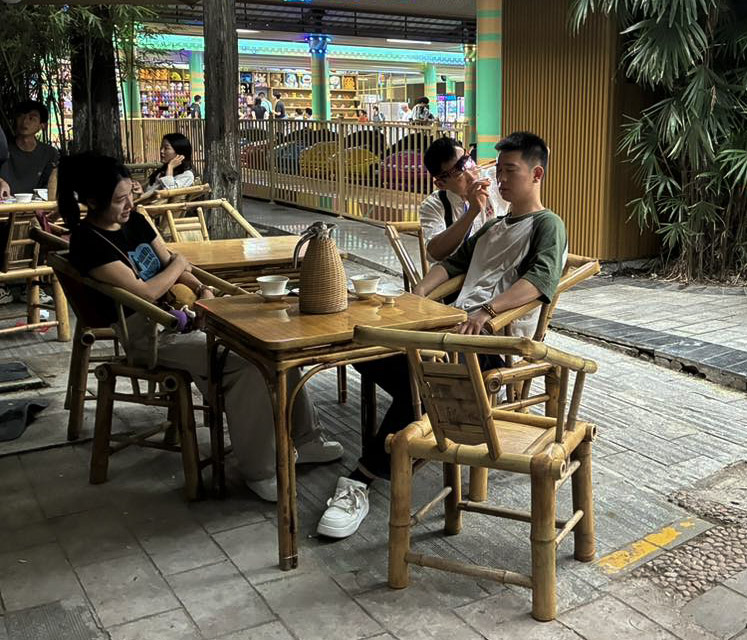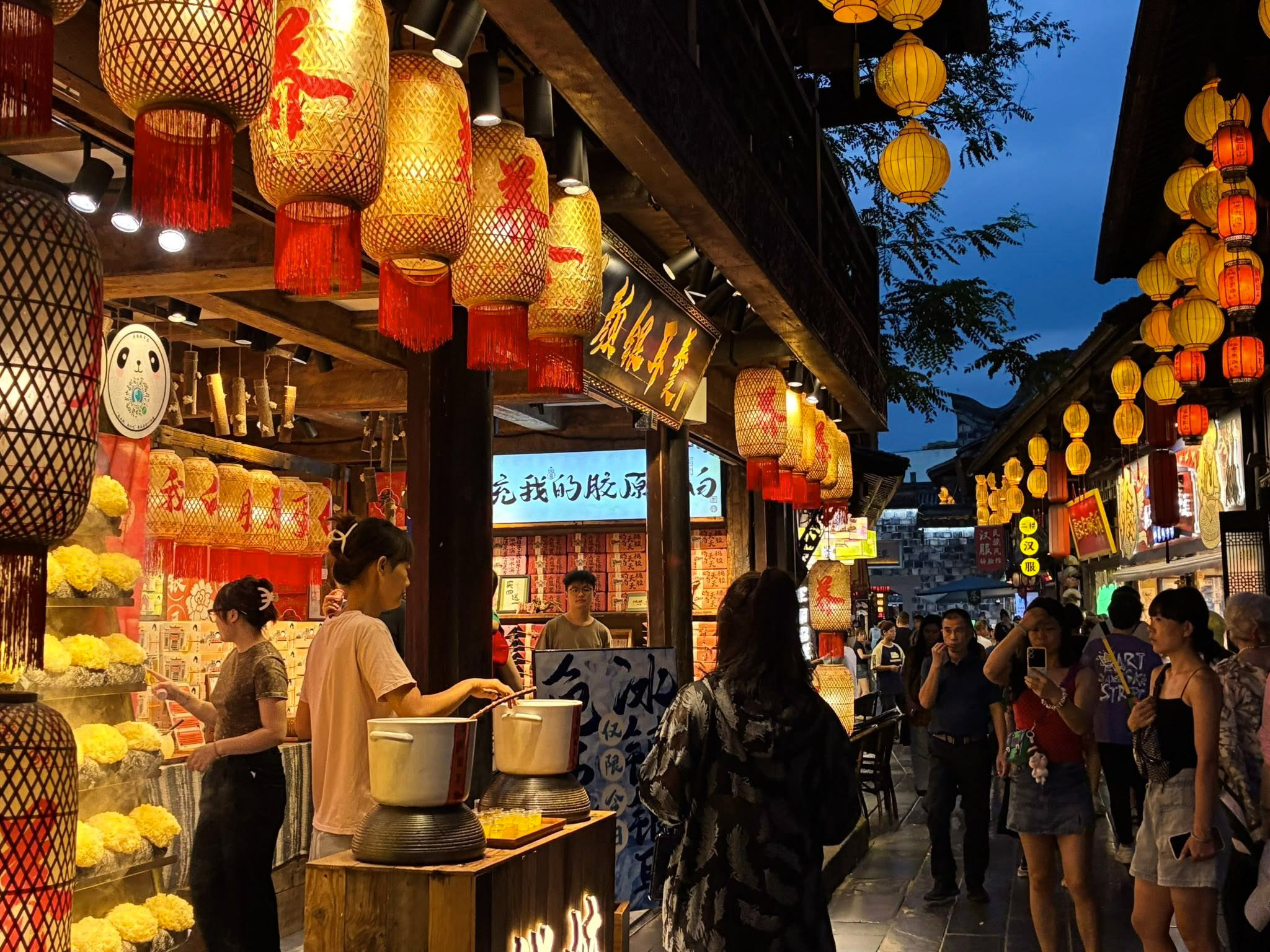Chengdu in a Day: Pandas, Teahouses & Hidden Alleys
Chengdu isn’t a city you rush through — it’s a city that invites you to slow down. Even in a single day, you can feel its rhythm: the clatter of mahjong tiles, the earthy aroma of jasmine tea, and the gentle buzz of scooters zipping through streets lined with red lanterns.
This 24-hour itinerary captures the essence of Chengdu in a day — a perfect balance of pandas, teahouses, ancient alleys, and Sichuan spice that reveals why locals call it “the land of abundance.”

Morning: Meet Chengdu’s Adorable Ambassadors
Stop 1: Chengdu Research Base of Giant Panda Breeding
Start early, around 7:30 AM, when the pandas are at their most playful. The Panda Base, located just outside the city, offers a glimpse of conservation in action. Watch the black-and-white giants nibble bamboo and roll around in their natural enclosures.
Travel Tip: Avoid visiting during holidays and arrive early to skip the crowds. Spend about two hours here before heading back to the city.

Late Morning: People’s Park – Teahouses, Matchmaking & Everyday Joy
Next, head downtown to People’s Park (Renmin Park) — the beating heart of Chengdu’s social life. This isn’t just a park; it’s a living theatre of the city’s soul.
The Pensioner’s Stage
Every morning, retirees gather under willow trees to sing revolutionary songs, perform opera, or dance in synchrony to old pop tunes. You might spot an elderly saxophonist, a spontaneous waltz, or even a chorus of patriotic anthems echoing across the lotus pond.
The Matchmaking Corner
Hidden near one of the teahouses lies Chengdu’s most romantic (and practical) tradition — the Matchmaking Wall. Parents proudly post handwritten notes advertising their adult children: age, height, income, education, and even zodiac sign! There’s no app here — just umbrellas pinned with paper bios fluttering in the breeze.

The Art of Doing Nothing
Settle into a rickety bamboo chair at Heming Teahouse, order a pot of jasmine or chrysanthemum tea, and watch life go by. Local tea masters top up your cup from brass kettles with meter-long spouts, pouring with acrobatic precision.
And then — a uniquely Chengdu offer: ear-cleaning. Yes, right at your table! With slender rods and tiny brushes, the ear cleaner works with surgical grace, accompanied by the soft tinkling of bells. It’s half spa, half spectacle — and oddly relaxing.
Cultural Tip: Ear cleaning dates back to the Tang dynasty and is seen as both hygiene and a social ritual in Chengdu’s teahouses.

Afternoon: Explore Xinli Ancient Alley — Chengdu’s Hidden Gem
After a soothing tea session, make your way to Xinli Ancient Alley (新丽古巷) — a lesser-known corner of the city that feels frozen in time. The narrow cobblestone lanes are lined with traditional courtyards, artisan shops, and tiny eateries serving homemade noodles and spicy wontons.
This area offers a glimpse into old Chengdu, untouched by the gleaming skyscrapers that surround it. Stroll past craft stalls, pick up local chili paste or tea leaves as souvenirs, catch a “face-changing” (bian lian) performance — actors switching masks in the blink of an eye, an art as mysterious as it is mesmerizing, and watch elderly residents play mahjong in the afternoon shade.
Pro Tip: Bring your camera — the weathered wood doors, red lanterns, and lazy cats make it a photographer’s dream.

Late Afternoon: The Famous Wide and Narrow Alleys (Kuanzhai Xiangzi)
As the sun begins to dip, head to Kuanzhai Alley, also known as the Wide and Narrow Alleys, one of Chengdu’s best-preserved historical quarters.
Here, Qing-dynasty courtyards have been transformed into boutique teahouses, craft stores, and Sichuan snack bars. The narrow lanes pulse with history — from opera face-changing (bian lian) performances to street musicians playing traditional erhu.
Grab a seat at a street café, order an iced Sichuan latte or local craft beer, and watch life unfold around you.
Insider Tip: Visit around 5–6 PM when the golden light hits the grey-brick walls, perfect for photos.

Evening: Dinner, Drinks & Night Vibes
By dinner time, Chengdu truly comes alive. Head to one of the hotpot restaurants near Kuanzhai Alley — the birthplace of Sichuan hotpot — and prepare for a fiery feast of chili oil, peppercorns, tofu, and beef slices.
If you prefer something lighter, try dan dan noodles, mapo tofu, or stir-fried lotus root at a small eatery nearby. Afterward, stroll through the lantern-lit alleys, where traditional courtyards hide speakeasy bars serving cocktails infused with Sichuan pepper.
Finish your night with a walk through Taikoo Li, a modern shopping and dining area that contrasts beautifully with the city’s ancient charm.

Evening: Fiery Sichuan Hotpot — Chengdu’s Signature Experience
No Chengdu visit is complete without hotpot. This bubbling cauldron of chili oil, Sichuan peppercorns, and secret spice blends is a ritual of its own. Locals gather around the steaming pot, dipping paper-thin beef, tofu, lotus root, and mushrooms — and daring each other to handle the heat.
How to Order Like a Local:
- Choose your spice level: wei la (mild), zhong la (medium), or te la (very spicy).
- Mix your own dipping sauce — sesame oil, garlic, cilantro, and vinegar help tame the fire.
- Cool your mouth with suannai (sweet yogurt) afterward!
After dinner, stroll back through Kuanzhai Alley or Taikoo Li, where red lanterns glow and street musicians fill the night air with soft melodies.

Travel Tips for One Day in Chengdu
Bonus Tip: Visit a local night market for late-night barbecue skewers, spicy noodles, and sweet flower cakes (huabing) — Chengdu’s favorite dessert filled with rose or osmanthus paste.
Getting Around: Use the metro (Line 2 or 3) or the DiDi taxi app. Both are safe and efficient.
Best Time to Visit: March to May and September to November for mild weather.
Payments: Bring cash or install Alipay/WeChat Pay (foreign cards rarely accepted).
Language Tip: Download Pleco or Google Translate to help with menus and signs.

Final Thoughts
In one day, Chengdu gives you a masterclass in how to live well — laughing over tea, celebrating spice, cherishing calm. Between pandas, pensioner performances, matchmaking walls, and ear-cleaning teahouses, you’ll find that this city isn’t just about seeing things — it’s about feeling life slow down.




Follow the rest of the China series
RESPONSIBLE TRAVELING-BECAUSE I CARE


